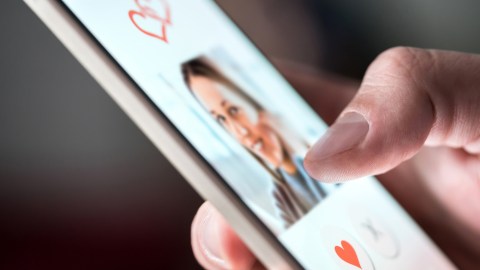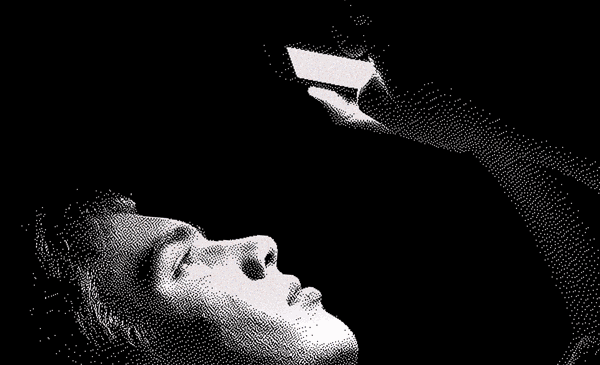How swipe-based dating apps are impacting your mental health

Photo by Tero Vesalainen on Shutterstock
- Some dating apps allow individuals to interact and form romantic/sexual connections before meeting face to face with the ability to “swipe” on the screen to either accept or reject another user’s profile. Popular swipe-based apps include Tinder, Bumble, and OkCupid.
- Research by Western Sydney University and the University of Sydney has linked the experience of swipe-based dating apps to higher rates of psychological distress and/or depression.
- Not all time spent on these apps is damaging, however. Up to 40 percent of current users say they previously entered a serious relationship with someone they met through one of these apps.
The last decade has seen a rapid rise in online dating, and with it, a whole new way of having fun and finding the one. Tracking the “evolution of online dating,” we learn that it actually started back in 1995 with the launch of Match.com.
Since then, swipe-based dating apps have taken over the online dating scene. These apps are a platform for individuals to interact and form romantic/sexual connections before meeting face to face with potential partners. What sets them apart from other online dating apps is the feature of “swiping” on the screen to either accept or reject another user’s profile. Some of the most common apps that use this method are Tinder, Bumble, Happn, and OkCupid.

Many people who use swipe-based dating apps report feeling psychological distress and depressive symptoms.Image by Odua Images on Shutterstock
Research by Western Sydney University and the University of Sydney has linked the experience of swipe-based dating apps to higher rates of psychological distress and/or depression.
An online survey (published in BMC Psychology) of over 430 individuals compared the impact of dating habits on the mental health of people who use swipe-based dating apps and those who don’t.
The measures used during this evaluation were the Kessler Psychological Distress Scale, the Generalised Anxiety Disorder-2 scale, the Patient Health Questionnaire-2, and the Rosenberg Self-Esteem Scale. An analysis of variance (a tool used in statistics that splits the data into two parts: systematic factors and random factors) was then used to consider all four mental health scores together.
High psychological distress levels among swipe-based dating app users.
20 percent of participants who use swipe-based dating apps reported a significantly higher level of psychological distress compared to those who didn’t use these apps.
Sabrina Pit, one of the researchers on the project, explains: “We found an increased frequency of use and longer duration of time using the apps were both associated with greater psychological distress and depression.”
Current swipe-based dating app users show more depressive symptoms than non-users.
19 percent of current users reported more depressive symptoms as a result of swipe-based dating app use, compared to 9 percent of the people surveyed who did not use a dating app.
“People who are currently using dating apps for a year or more were 3.5 times more likely to be distressed and 4 times more likely to report probable depression,” Pit explains in an interview with Global Dating Insights.
People are spending more and more time on dating apps.
A study of 5,000 people between the ages of 18-30 years old shows that people are spending an average of 10 hours per week on dating apps alone. Men were logging on to check their status on dating apps 9 times a day, with women logging on 10 times per day to check their potential matches. How much time are they spending on these apps? Well, men were found to be spending 85 minutes per day on these apps, with women spending 79 minutes each day.
This amount of time spent on dating apps could boost the negative impacts we have seen through the study listed above.

It’s not all bad – 40% of current swipe-based dating app users report a positive mental health impact from using these apps.Image by Jambulart studio on Shutterstock
While the study proved that there are significant negative mental health risks that follow using swipe-based dating apps for longer periods of time, not all time spent on these apps is damaging.
“The findings highlight that dating apps with swiping functions have a complex impact on the psychological well-being of users,” Pit explains. Although the findings of this study are worrisome, there are some benefits that were also highlighted in the results.
Connections and serious relationships are being formed.
Up to 40 percent of current swipe-based dating app users said they had previously entered a serious relationship with someone they met through one of these apps. 77 percent of people who reported using these apps also said they had met people face-to-face, with 26 percent of these people saying they had met more than 5 people through the apps.
This connection with others leads to a positive impact on self-esteem.
Meeting people, dating, and finding serious relationships through swipe-based dating apps has proven to have a positive impact on mental health as well, with up to 40 percent of individuals using these apps claiming it’s had a positive impact on their self-esteem.
Dating apps connect us with people we’d never meet otherwise.
Back in 1995 when Match.com launched, there was a spike in interracial marriages. In today’s society, these swipe-based dating apps allow you to browse based on where you are. If you move to a new city, your dating pool changes. The benefits of being able to connect with people we otherwise wouldn’t meet is one of the best things dating apps have given us.
Did you know that 70 percent of same-sex relationships start through dating apps?
With the launch of Grindr in 2009, there was what can only be described as a sexual revolution within the LGBTQ+ community. Finding a partner became easier, safer, and more common. Not only was Grindr the first dating app that focused on the LGBTQ+ community, but it was also one of the first to use geolocation technology.
It’s safe to say that digital dating isn’t leaving us anytime soon, and neither is the use of swipe-based dating. There are negative and positive impacts of swipe-based dating apps on our mental health, but the questions is how can we increase the positive and decrease the negative?
The study by these two Australian universities isn’t the first to question the mental health impact of dating apps. Back in 2017, an unrelated study linked the use of Tinder with negative self-esteem and body shame.
One of the researchers on the Australian-based study explains: “We are calling for app developers to take a more active role in the promotion of positive mental health messages, particularly on swipe-based dating applications.”





